Heterogeneous Cellular Response of Primary and Metastatic Human Gastric Adenocarcinoma Cell Lines to Magnoflorine and Its Additive Interaction with Docetaxel
Abstract
:1. Introduction
2. Results
2.1. MGN and DCT Impact on the Viability/Proliferation of ACC-201, AGS, MKN-74 and NCI-N87 Human GC Cell Lines in a Dose-Dependent Manner
2.2. MGN Treatment Induces Apoptosis in ACC-201, AGS, MKN-74 and NCI-N87 Human GC Cell Lines
2.3. MGN Treatment Induces Changes in the Cell Cycle Progression of ACC-201, AGS, MKN-74 and NCI-N87 Human GC Cell Lines
2.4. Anti-Proliferative Effect of DCT and MGN Administered in Combination in GC Cell Lines (ACC-201, AGS, MKN-74 and NCI-N87)
2.5. Analysis of Pharmacological Interaction between MGN and DCT Using Isobolographic Method
2.6. Developmental Toxicity of MGN in Zebrafish
3. Discussion
4. Materials and Methods
4.1. Compounds
4.2. Cell Lines Culture
4.3. MTT Assay
4.4. BrdU Incorporation Assay
4.5. Cell Cycle Analysis
4.6. Active Caspase-3 Analysis
4.7. Isobolographic Analysis
4.8. Zebrafish Studies
4.9. Statistical Analysis
5. Conclusions
Supplementary Materials
Author Contributions
Funding
Institutional Review Board Statement
Informed Consent Statement
Data Availability Statement
Acknowledgments
Conflicts of Interest
References
- Morgan, E.; Arnold, M.; Camargo, M.; Gini, A.; Kunzmann, A.; Matsuda, T.; Meheus, F.; Verhoeven, R.; Vignat, J.; Laversanne, M.; et al. The current and future incidence and mortality of gastric cancer in 185 countries, 2020–2040: A population-based modelling study. EClinicalMedicine 2022, 47, 101404. [Google Scholar] [CrossRef] [PubMed]
- Sitarz, R.; Skierucha, M.; Mielko, J.; Offerhaus, G.; Maciejewski, R.; Polkowski, W. Gastric cancer: Epidemiology, prevention, classification, and treatment. Cancer Manag. Res. 2018, 10, 239–248. [Google Scholar] [CrossRef] [PubMed]
- Rawla, P.; Barsouk, A. Epidemiology of gastric cancer: Global trends, risk factors and prevention. Prz. Gastroenterol. 2019, 14, 26–38. [Google Scholar] [CrossRef] [PubMed]
- Li, Y.; Feng, A.; Zheng, S.; Chen, C.; Lyu, J. Recent Estimates and Predictions of 5-Year Survival in Patients with Gastric Cancer: A Model-Based Period Analysis. Cancer Control J. Moffitt Cancer Cent. 2022, 29, 10732748221099227. [Google Scholar] [CrossRef]
- Jin, X.; Liu, Z.; Yang, D.; Yin, K.; Chang, X. Recent Progress and Future Perspectives of Immunotherapy in Advanced Gastric Cancer. Front. Immunol. 2022, 13, 948647. [Google Scholar] [CrossRef] [PubMed]
- Habli, Z.; Toumieh, G.; Fatfat, M.; Rahal, O.; Gali-Muhtasib, H. Emerging Cytotoxic Alkaloids in the Battle against Cancer: Overview of Molecular Mechanisms. Molecules 2017, 22, 250. [Google Scholar] [CrossRef]
- Petrovska, B. Historical review of medicinal plants’ usage. Pharmacogn. Rev. 2012, 6, 1–5. [Google Scholar] [CrossRef]
- Dzobo, K. The Role of Natural Products as Sources of Therapeutic Agents for Innovative Drug Discovery. Compr. Pharmacol. 2022, 408–422. [Google Scholar] [CrossRef]
- Du, K.; Ma, W.; Yang, C.; Zhou, Z.; Hu, S.; Tian, Y.; Zhang, H.; Ma, Y.; Jiang, X.; Zhu, H.; et al. Design, synthesis, and cytotoxic activities of isaindigotone derivatives as potential anti-gastric cancer agents. J. Enzym. Inhib. Med. Chem. 2022, 37, 1212–1226. [Google Scholar] [CrossRef]
- Khan, T.; Ali, M.; Khan, A.; Nisar, P.; Jan, S.; Afridi, S.; Shinwari, Z. Anticancer Plants: A Review of the Active Phytochemicals, Applications in Animal Models, and Regulatory Aspects. Biomolecules 2019, 10, 47. [Google Scholar] [CrossRef]
- Rahimi-Madiseh, M.; Lorigoini, Z.; Zamani-Gharaghoshi, H.; Rafieian-Kopaei, M. Berberis vulgaris: Specifications and traditional uses. Iran. J. Basic Med. Sci. 2017, 20, 569–587. [Google Scholar] [CrossRef] [PubMed]
- Szalak, R.; Matysek, M.; Koval, M.; Dziedzic, M.; Kowalczuk-Vasilev, E.; Kruk-Slomka, M.; Koch, W.; Arciszewski, M.; Kukula-Koch, W. Magnoflorine from Berberis vulgaris Roots-Impact on Hippocampal Neurons in Mice after Short-Term Exposure. Int. J. Mol. Sci. 2023, 24, 7166. [Google Scholar] [CrossRef] [PubMed]
- Chang, L.; Wang, Q.; Ju, J.; Li, Y.; Cai, Q.; Hao, L.; Zhou, Y. Magnoflorine Ameliorates Inflammation and Fibrosis in Rats With Diabetic Nephropathy by Mediating the Stability of Lysine-Specific Demethylase 3A. Front. Physiol. 2020, 11, 580406. [Google Scholar] [CrossRef] [PubMed]
- Xu, T.; Kuang, T.; Du, H.; Li, Q.; Feng, T.; Zhang, Y.; Fan, G. Magnoflorine: A review of its pharmacology, pharmacokinetics and toxicity. Pharmacol. Res. 2020, 152, 104632. [Google Scholar] [CrossRef] [PubMed]
- He, L.; Zhong, Z.; Chen, M.; Liang, Q.; Wang, Y.; Tan, W. Current Advances in Coptidis Rhizoma for Gastrointestinal and Other Cancers. Front. Pharmacol. 2022, 12, 775084. [Google Scholar] [CrossRef]
- Okon, E.; Kukula-Koch, W.; Halasa, M.; Jarzab, A.; Baran, M.; Dmoszynska-Graniczka, M.; Angelis, A.; Kalpoutzakis, E.; Guz, M.; Stepulak, A.; et al. Magnoflorine-Isolation and the Anticancer Potential against NCI-H1299 Lung, MDA-MB-468 Breast, T98G Glioma, and TE671 Rhabdomyosarcoma Cancer Cells. Biomolecules 2020, 10, 1532. [Google Scholar] [CrossRef]
- Okon, E.; Kukula-Koch, W.; Jarzab, A.; Halasa, M.; Stepulak, A.; Wawruszak, A. Advances in Chemistry and Bioactivity of Magnoflorine and Magnoflorine-Containing Extracts. Int. J. Mol. Sci. 2020, 21, 1330. [Google Scholar] [CrossRef]
- Saini, N.; Grewal, A.; Lather, V.; Gahlawat, S. Natural alkaloids targeting EGFR in non-small cell lung cancer: Molecular docking and ADMET predictions. Chem.-Biol. Interact. 2022, 358, 109901. [Google Scholar] [CrossRef]
- Sun, X.; Zhang, X.; Zhai, H.; Zhang, D.; Ma, S. Magnoflorine inhibits human gastric cancer progression by inducing autophagy, apoptosis and cell cycle arrest by JNK activation regulated by ROS. Biomed. Pharmacother. Biomed. Pharmacother. 2020, 125, 109118. [Google Scholar] [CrossRef]
- Wang, Y.; Shang, G.; Wang, W.; Qiu, E.; Pei, Y.; Zhang, X. Magnoflorine inhibits the malignant phenotypes and increases cisplatin sensitivity of osteosarcoma cells via regulating miR-410-3p/HMGB1/NF-κB pathway. Life Sci. 2020, 256, 117967. [Google Scholar] [CrossRef]
- Vollmers, H.; Stulle, K.; Dämmrich, J.; Pfaff, M.; Papadopoulos, T.; Betz, C.; Saal, K.; Müller-Hermelink, H. Characterization of four new gastric cancer cell lines. Virchows Archiv. B Cell Pathol. Incl. Mol. Pathol. 1993, 63, 335–343. [Google Scholar] [CrossRef] [PubMed]
- Saraiva-Pava, K.; Navabi, N.; Skoog, E.; Lindén, S.; Oleastro, M.; Roxo-Rosa, M. New NCI-N87-derived human gastric epithelial line after human telomerase catalytic subunit over-expression. World J. Gastroenterol. 2015, 21, 6526–6542. [Google Scholar] [CrossRef] [PubMed]
- Lu, S.; Ma, Y.; Sun, T.; Ren, R.; Zhang, X.; Ma, W. Expression of α-fetoprotein in gastric cancer AGS cells contributes to invasion and metastasis by influencing anoikis sensitivity. Oncol. Rep. 2016, 35, 2984–2990. [Google Scholar] [CrossRef]
- Balmaña, M.; Mereiter, S.; Diniz, F.; Feijão, T.; Barrias, C.; Reis, C. Multicellular Human Gastric-Cancer Spheroids Mimic the Glycosylation Phenotype of Gastric Carcinomas. Molecules 2018, 23, 2815. [Google Scholar] [CrossRef] [PubMed]
- Park, J.; Frucht, H.; LaRocca, R.; Bliss, D.; Kurita, Y.; Chen, T.; Henslee, J.; Trepel, J.; Jensen, R.; Johnson, B. Characteristics of cell lines established from human gastric carcinoma. Cancer Res. 1990, 50, 2773–2780. [Google Scholar]
- Yu, J.; Wang, Z.; Wang, Y. BrdU Incorporation Assay to Analyze the Entry into S Phase. Methods Mol. Biol. 2022, 2579, 209–226. [Google Scholar] [CrossRef]
- Shin, W.; Xie, F.; Chen, B.; Yu, P.; Yu, J.; To, K.; Kang, W. Updated Epidemiology of Gastric Cancer in Asia: Decreased Incidence but Still a Big Challenge. Cancers 2023, 15, 2639. [Google Scholar] [CrossRef]
- Wei, T.; Xiaojun, X.; Peilong, C. Magnoflorine improves sensitivity to doxorubicin (DOX) of breast cancer cells via inducing apoptosis and autophagy through AKT/mTOR and p38 signaling pathways. Biomed. Pharmacother. Biomed. Pharmacother. 2020, 121, 109139. [Google Scholar] [CrossRef]
- Fu, J.; Jia, Q.; Liang, P.; Wang, S.; Zhou, H.; Zhang, L.; Gao, C.; Wang, H.; Lv, Y.; Han, S. Targeting and Covalently Immobilizing the EGFR through SNAP-Tag Technology for Screening Drug Leads. Anal. Chem. 2021, 93, 11719–11728. [Google Scholar] [CrossRef]
- Qian, C.; Mei, Y.; Zhang, J. Cancer metastasis: Issues and challenges. Chin. J. Cancer 2017, 36, 38. [Google Scholar] [CrossRef]
- Zhang, Y.; Lin, Y.; Duan, J.; Xu, K.; Mao, M.; Wang, X. A Population-Based Analysis of Distant Metastasis in Stage IV Gastric Cancer. Med. Sci. Monit. 2020, 26, e923867. [Google Scholar] [CrossRef] [PubMed]
- Li, Y.; Li, B.; Xiang, C.; Zhang, Y.; Li, Y.; Wu, X. Characterization of gastric cancer models from different cell lines orthotopically constructed using improved implantation techniques. World J. Gastroenterol. 2012, 18, 136–143. [Google Scholar] [CrossRef]
- Bian, X.; Yang, Z.; Feng, H.; Sun, H.; Liu, Y. A Combination of Species Identification and STR Profiling Identifies Cross-contaminated Cells from 482 Human Tumor Cell Lines. Sci. Rep. 2017, 7, 9774. [Google Scholar] [CrossRef]
- Peng, B.; Singh, A.; Chan, C.; Deng, Y.; Li, P.; Su, C.; Wu, C.; Deng, W. AGA induces sub-G1 cell cycle arrest and apoptosis in human colon cancer cells through p53-independent/p53-dependent pathway. BMC Cancer 2023, 23, 1. [Google Scholar] [CrossRef] [PubMed]
- Park, S.; Lee, J.; Kim, Y.; Park, J.; Shin, J.; Nam, S. Clinical Relevance and Molecular Phenotypes in Gastric Cancer, of TP53 Mutations and Gene Expressions, in Combination with Other Gene Mutations. Sci. Rep. 2016, 6, 34822. [Google Scholar] [CrossRef] [PubMed]
- Hientz, K.; Mohr, A.; Bhakta-Guha, D.; Efferth, T. The role of p53 in cancer drug resistance and targeted chemotherapy. Oncotarget 2017, 8, 8921–8946. [Google Scholar] [CrossRef] [PubMed]
- Matozaki, T.; Sakamoto, C.; Matsuda, K.; Suzuki, T.; Konda, Y.; Nakano, O.; Wada, K.; Uchida, T.; Nishisaki, H.; Nagao, M. Missense mutations and a deletion of the p53 gene in human gastric cancer. Biochem. Biophys. Res. Commun. 1992, 182, 215–223. [Google Scholar] [CrossRef]
- Mashima, T.; Oh-hara, T.; Sato, S.; Mochizuki, M.; Sugimoto, Y.; Yamazaki, K.; Hamada, J.; Tada, M.; Moriuchi, T.; Ishikawa, Y.; et al. p53-defective tumors with a functional apoptosome-mediated pathway: A new therapeutic target. J. Natl. Cancer Inst. 2005, 97, 765–777. [Google Scholar] [CrossRef]
- COSMIC-Catalogue of Somatic Mutations in Cancer. 2023. Available online: https://cancer.sanger.ac.uk/cell_lines (accessed on 1 March 2023).
- Kim, J.; Takahashi, T.; Chiba, I.; Park, J.; Birrer, M.; Roh, J.; De Lee, H.; Kim, J.; Minna, J.; Gazdar, A. Occurrence of p53 gene abnormalities in gastric carcinoma tumors and cell lines. J. Natl. Cancer Inst. 1991, 83, 938–943. [Google Scholar] [CrossRef]
- Ke, X.; Qin, Q.; Deng, T.; Liao, Y.; Gao, S. Heterogeneous Responses of Gastric Cancer Cell Lines to Tenovin-6 and Synergistic Effect with Chloroquine. Cancers 2020, 12, 365. [Google Scholar] [CrossRef]
- Wu, J.; Li, Y.; He, Q.; Yang, X. Exploration of the Use of Natural Compounds in Combination with Chemotherapy Drugs for Tumor Treatment. Molecules 2023, 28, 1022. [Google Scholar] [CrossRef] [PubMed]
- Kubczak, M.; Szustka, A.; Rogalińska, M. Molecular Targets of Natural Compounds with Anti-Cancer Properties. Int. J. Mol. Sci. 2021, 22, 3659. [Google Scholar] [CrossRef]
- Sauter, E. Cancer prevention and treatment using combination therapy with natural compounds. Expert Rev. Clin. Pharmacol. 2020, 13, 265–285. [Google Scholar] [CrossRef]
- Naeem, A.; Hu, P.; Yang, M.; Zhang, J.; Liu, Y.; Zhu, W.; Zheng, Q. Natural Products as Anticancer Agents: Current Status and Future Perspectives. Molecules 2022, 27, 8367. [Google Scholar] [CrossRef] [PubMed]
- Pourghasemian, M.; Danandeh Mehr, A.; Molaei, M.; Habibzadeh, A. Outcome of FOLFOX and Modified DCF Chemotherapy Regimen in Patients with Advanced Gastric Adenocarcinoma. Asian Pac. J. Cancer Prev. 2020, 21, 2337–2341. [Google Scholar] [CrossRef]
- Arslan, C.; Atilla, F. Modified docetaxel, cisplatin, and 5-fluorouracil combination regimen and capecitabine maintenance in metastatic gastric cancer: Toxicity and efficacy results. Support. Care Cancer Off. J. Multinatl. Assoc. Support. Care Cancer 2022, 30, 4447–4455. [Google Scholar] [CrossRef]
- Ostwal, V.; Bose, S.; Sirohi, B.; Poladia, B.; Sahu, A.; Bhargava, P.; Doshi, V.; Dusane, R.; Nashikkar, C.; Shrikhande, S.; et al. Docetaxel/Oxaliplatin/Capecitabine (TEX) triplet followed by continuation monotherapy in advanced gastric cancer. Indian J. Cancer 2018, 55, 88–93. [Google Scholar] [CrossRef] [PubMed]
- Okon, E.; Luszczki, J.; Kukula-Koch, W.; Halasa, M.; Jarzab, A.; Khurelbat, D.; Stepulak, A.; Wawruszak, A. Synergistic or Additive Pharmacological Interactions between Magnoflorine and Cisplatin in Human Cancer Cells of Different Histological Origin. Int. J. Mol. Sci. 2020, 21, 2848. [Google Scholar] [CrossRef] [PubMed]
- Wiley, D.; Redfield, S.; Zon, L. Chemical screening in zebrafish for novel biological and therapeutic discovery. Methods Cell Biol. 2017, 138, 651–679. [Google Scholar] [CrossRef] [PubMed]
- Sangermano, F.; Masi, M.; Kumar, A.; Peravali, R.; Tuzi, A.; Cimmino, A.; Vallone, D.; Giamundo, G.; Conte, I.; Evidente, A.; et al. In Vitro and In Vivo Toxicity Evaluation of Natural Products with Potential Applications as Biopesticides. Toxins 2021, 13, 805. [Google Scholar] [CrossRef]
- Litchfield, J.; Wilcoxon, F. A simplified method of evaluating dose-effect experiments. J. Pharmacol. Exp. Ther. 1949, 96, 99–113. [Google Scholar] [PubMed]
- Luszczki, J. Isobolographic analysis of interaction between drugs with nonparallel dose-response relationship curves: A practical application. Naunyn-Schmiedebergs Arch. Pharmacol. 2007, 375, 105–114. [Google Scholar] [CrossRef] [PubMed]
- Tallarida, R.; Porreca, F.; Cowan, A. Statistical analysis of drug-drug and site-site interactions with isobolograms. Life Sci. 1989, 45, 947–961. [Google Scholar] [CrossRef]
- Grabovsky, Y.; Tallarida, R. Isobolographic analysis for combinations of a full and partial agonist: Curved isoboles. J. Pharmacol. Exp. Ther. 2004, 310, 981–986. [Google Scholar] [CrossRef]
- Tallarida, R. Combination analysis. Adv. Exp. Med. Biol. 2010, 678, 133–137. [Google Scholar] [CrossRef]
- Marzęda, P.; Wróblewska-Łuczka, P.; Drozd, M.; Florek-Łuszczki, M.; Załuska-Ogryzek, K.; Łuszczki, J. Cannabidiol Interacts Antagonistically with Cisplatin and Additively with Mitoxantrone in Various Melanoma Cell Lines-An Isobolographic Analysis. Int. J. Mol. Sci. 2022, 23, 6752. [Google Scholar] [CrossRef] [PubMed]
- Tallarida, R. Drug Combinations: Tests and Analysis with Isoboles. Curr. Protoc. Pharmacol. 2016, 72, 9.19.1–9.19.19. [Google Scholar] [CrossRef] [PubMed]
- OECD. Test No. 236: Fish Embryo Acute Toxicity (FET) Test, OECD Guidelines for the Testing of Chemicals, Section 2; OECD: Paris, France, 2013. [Google Scholar]
- Nakonieczna, S.; Grabarska, A.; Gawel, K.; Wróblewska-Łuczka, P.; Czerwonka, A.; Stepulak, A.; Kukula-Koch, W. Isoquinoline Alkaloids from Coptis chinensis Franch: Focus on Coptisine as a Potential Therapeutic Candidate against Gastric Cancer Cells. Int. J. Mol. Sci. 2022, 23, 10330. [Google Scholar] [CrossRef] [PubMed]
- Gawel, K.; Kukula-Koch, W.; Banono, N.; Nieoczym, D.; Targowska-Duda, K.; Czernicka, L.; Parada-Turska, J.; Esguerra, C. 6-Gingerol, a Major Constituent of Zingiber officinale Rhizoma, Exerts Anticonvulsant Activity in the Pentylenetetrazole-Induced Seizure Model in Larval Zebrafish. Int. J. Mol. Sci. 2021, 22, 7745. [Google Scholar] [CrossRef] [PubMed]
- Gawel, K.; Turski, W.; van der Ent, W.; Mathai, B.; Kirstein-Smardzewska, K.; Simonsen, A.; Esguerra, C. Phenotypic Characterization of Larval Zebrafish (Danio rerio) with Partial Knockdown of the cacna1a Gene. Mol. Neurobiol. 2020, 57, 1904–1916. [Google Scholar] [CrossRef]
- Tallarida, R. Quantitative methods for assessing drug synergism. Genes Cancer 2011, 2, 1003–1008. [Google Scholar] [CrossRef] [PubMed]
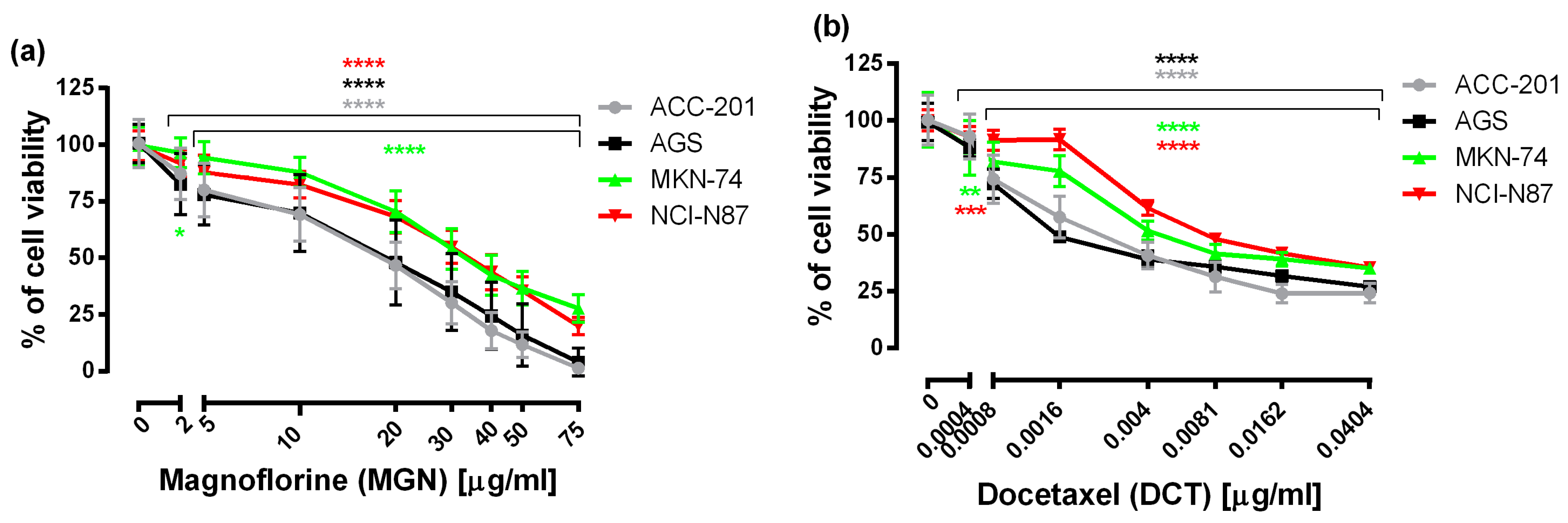

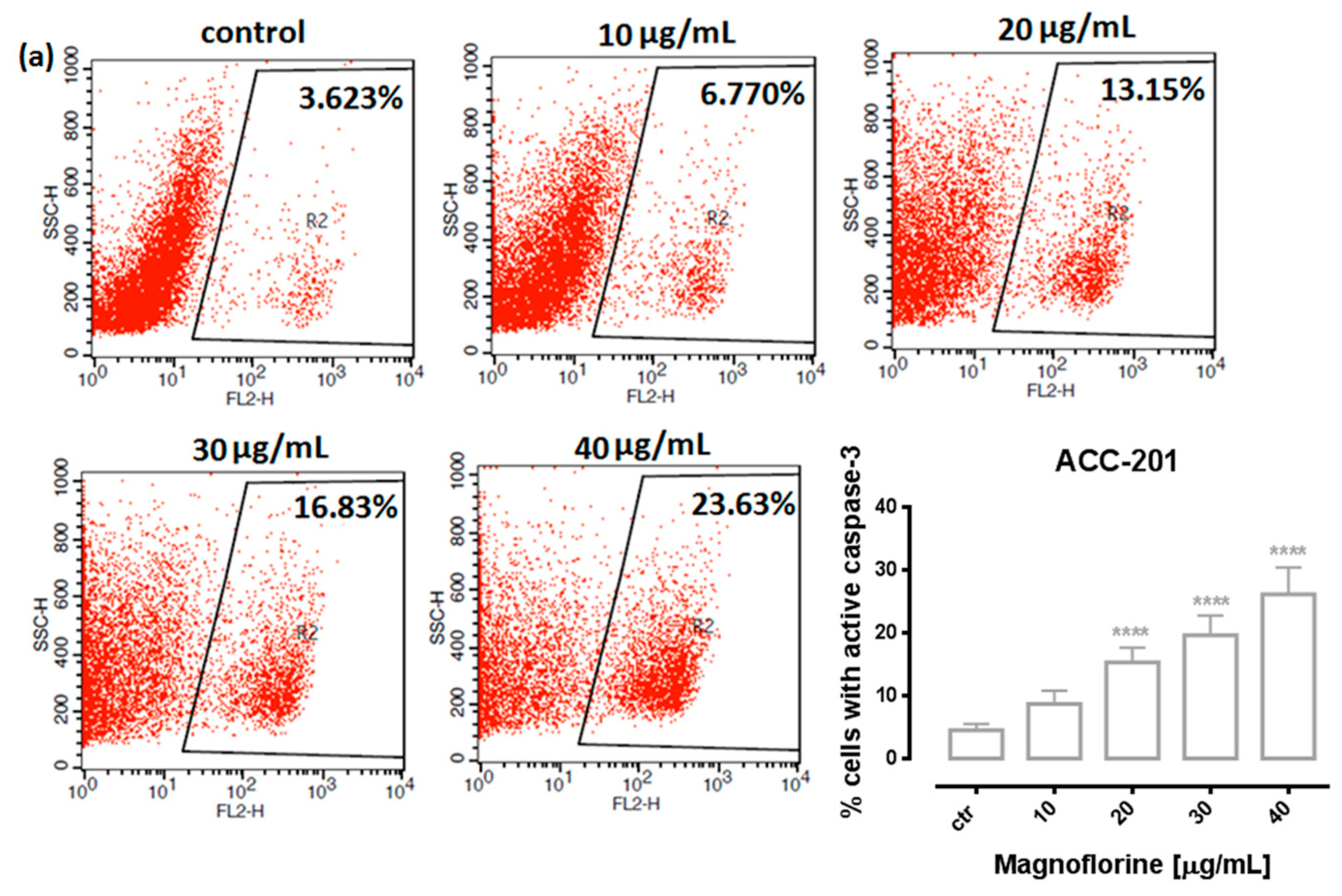

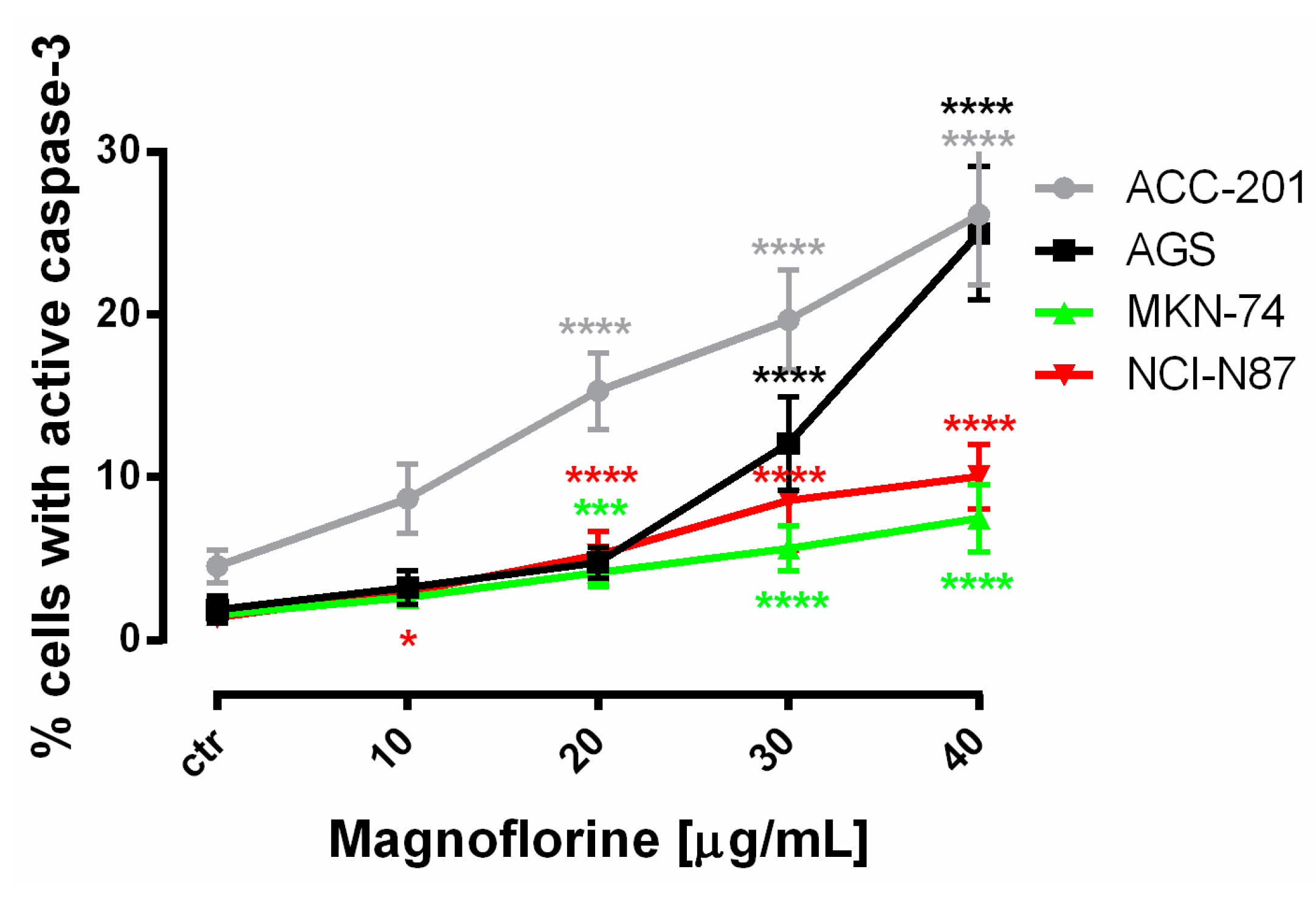


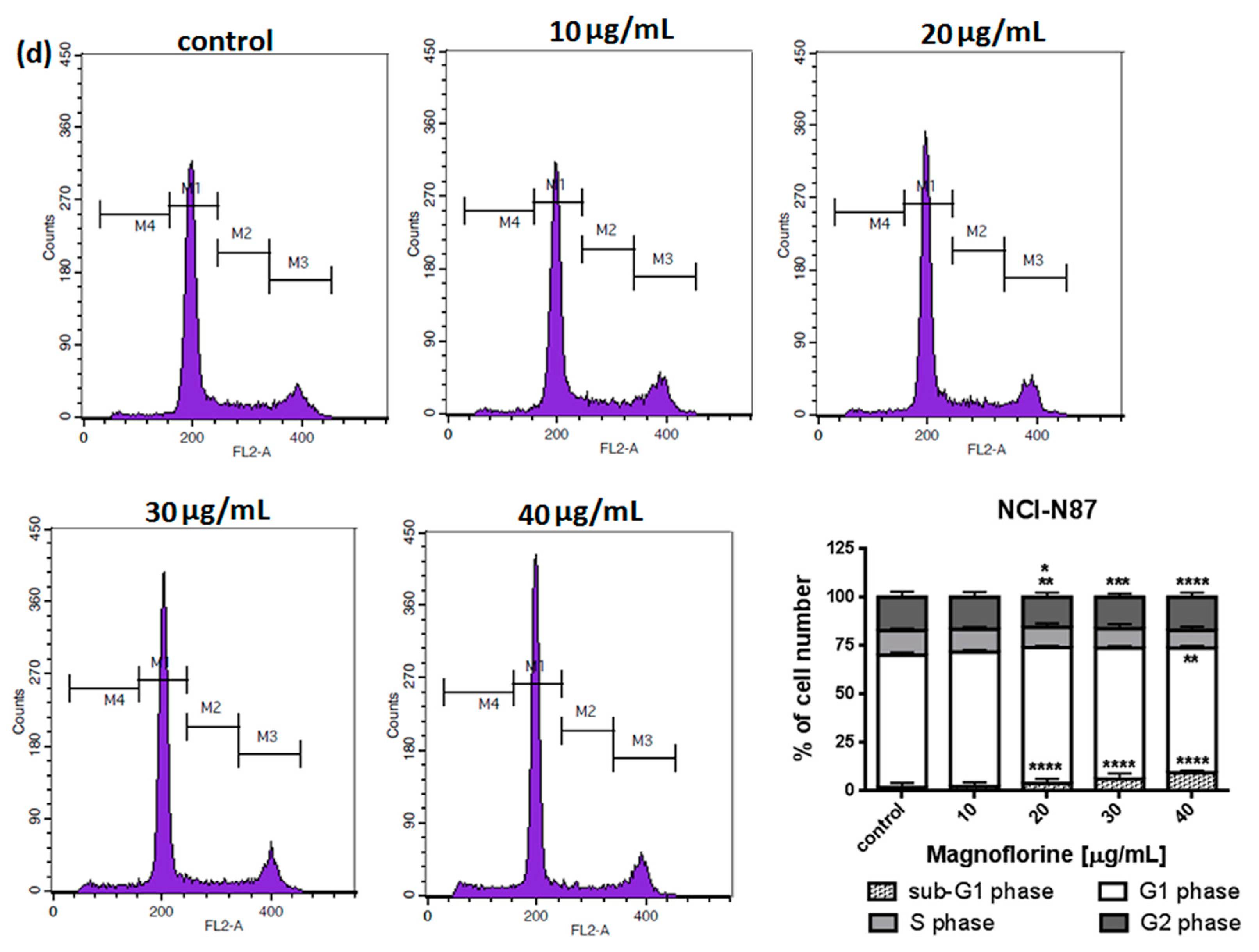


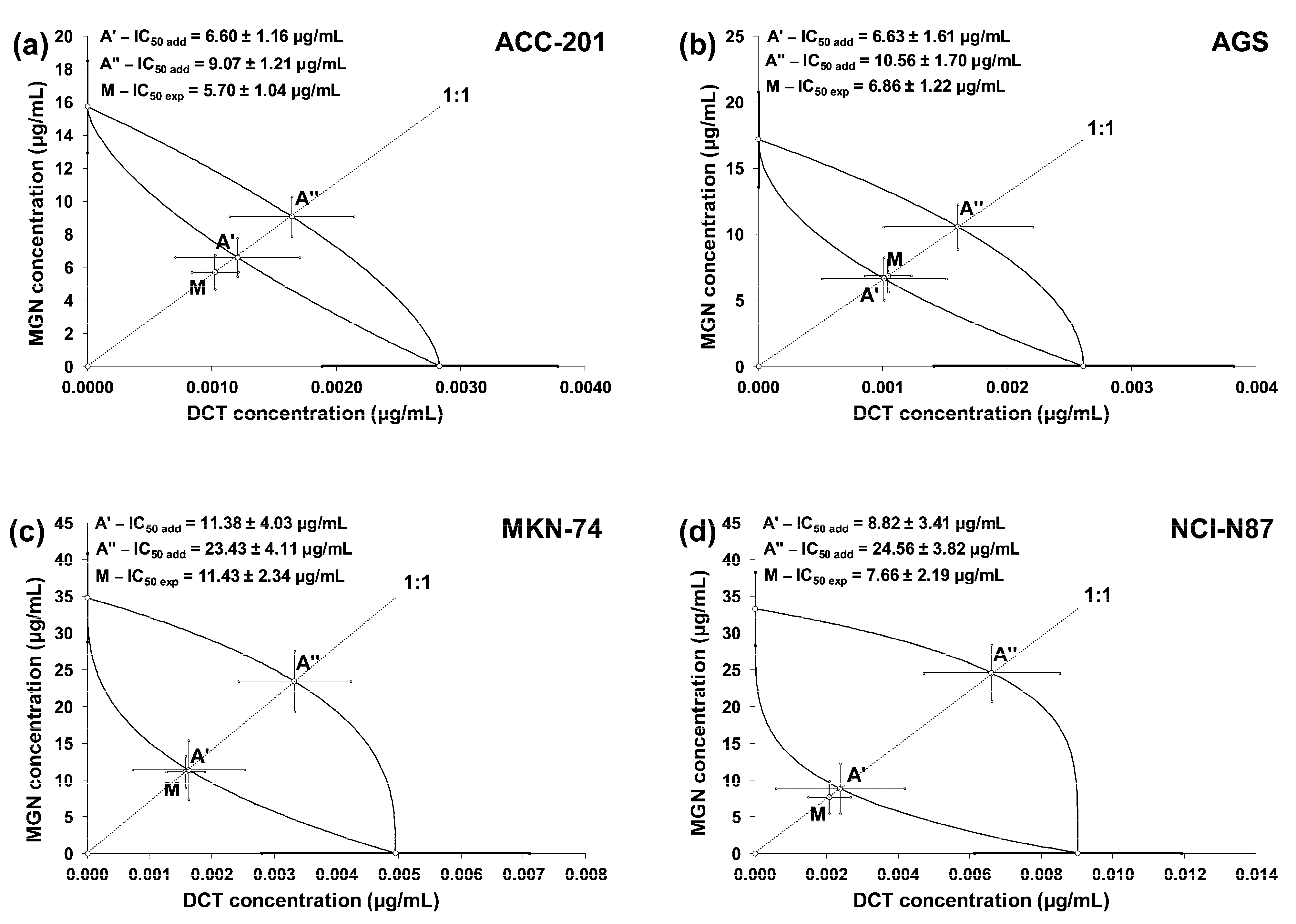


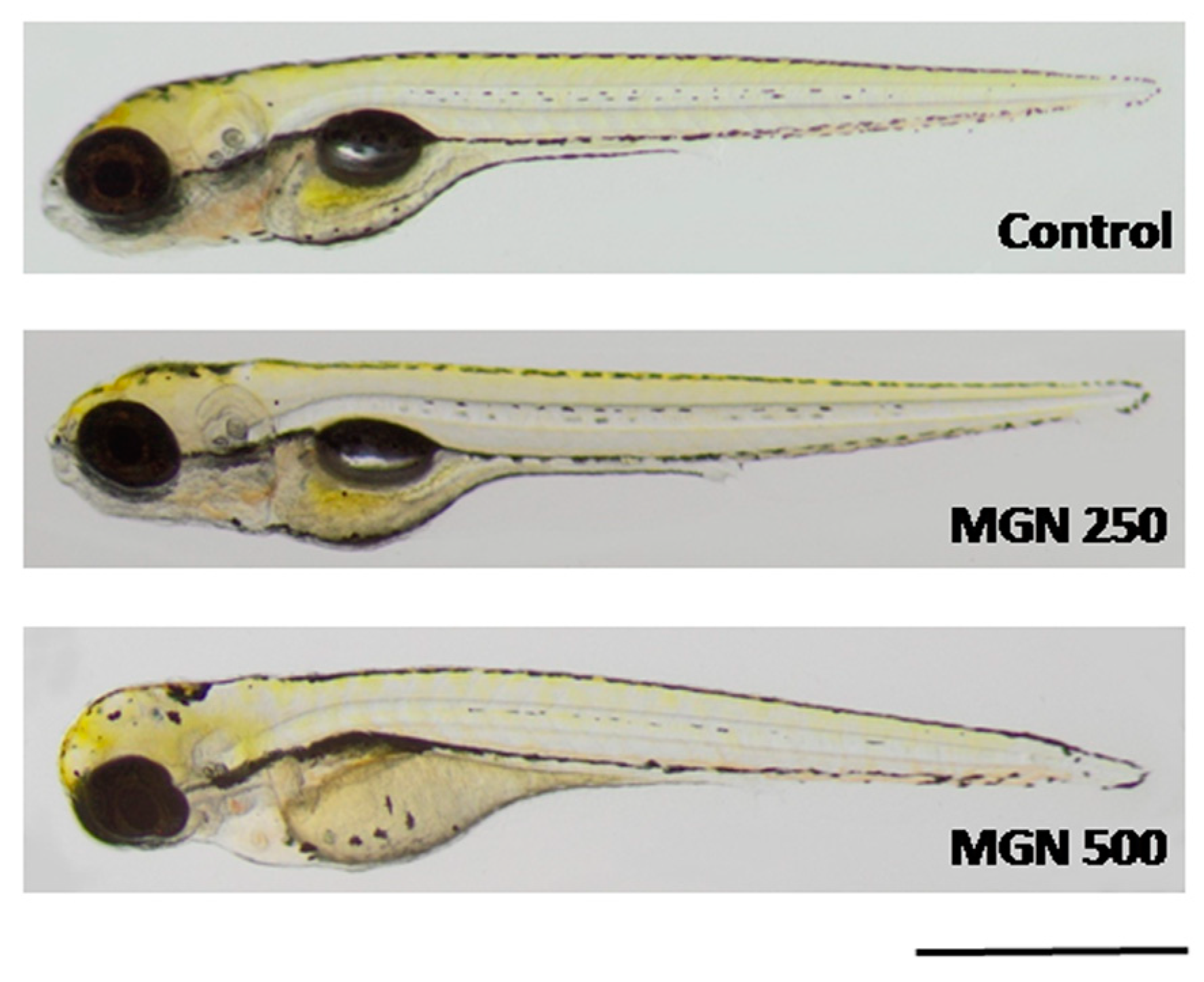
| Drug/Cell Line | ACC-201 | AGS | MKN-74 | NCI-N87 |
|---|---|---|---|---|
| MGN | 15.75 ± 2.79 | 17.19 ± 3.59 | 34.82 ± 6.04 | 33.31 ± 5.00 |
| DCT | 0.0028 ± 0.0009 | 0.0026 ± 0.0012 | 0.0049 ± 0.0021 | 0.0090 ± 0.0029 |
| Cell Line | Control | 10 µg/mL | 20 µg/mL | 30 µg/mL | 40 µg/mL |
|---|---|---|---|---|---|
| ACC-201 | 3.623 ± 0.416 | 6.770 ± 0.866 | 13.150 **** ± 0.962 | 16.830 **** ± 1.258 | 23.630 **** ± 1.758 |
| AGS | 1.222 ± 0.336 | 2.390 ± 0.411 | 4.172 ± 0.422 | 12.070 **** ± 1.451 | 24.980 **** ± 2.048 |
| MKN-74 | 1.580 ± 0.065 | 2.633 ± 0.069 | 4.148 *** ± 0.316 | 5.636 **** ± 0.398 | 7.481 **** ± 0.725 |
| NCI-N87 | 1.396 ± 0.086 | 2.948 * ± 0.133 | 5.233 **** ± 0.310 | 8.568 **** ± 0.652 | 10.030 **** ± 0.398 |
| Cell Line | Phase | Control | 10 µg/mL | 20 µg/mL | 30 µg/mL | 40 µg/mL |
|---|---|---|---|---|---|---|
| ACC-201 | subG1 | 9.91% ± 2.376 | 18.52% * ± 1.414 | 26.06% *** ± 1.399 | 38.50% **** ± 1.886 | 51.43% **** ± 2.072 |
| G1 | 67.05% ± 1.547 | 62.76% *** ± 2.434 | 57.23% **** ± 2.112 | 49.55% **** ± 1.820 | 39.27% **** ± 3.408 | |
| S | 9.68% ± 1.596 | 8.74% ± 3.423 | 8.33% ± 1.647 | 6.16% **** ± 1.340 | 5.61% **** ± 1.874 | |
| G2 | 13.12% ± 5.442 | 9.96% **** ± 3.707 | 8.34% **** ± 4.237 | 5.87% **** ± 5.399 | 3.74% **** ± 1.615 | |
| AGS | subG1 | 0.55% ± 2.249 | 1.19% ± 2.437 | 2.17% ± 2.519 | 2.17% ± 3.000 | 2.98% ± 2.448 |
| G1 | 61.82% ± 4.089 | 58.09% ± 8.195 | 53.06% ± 12.980 | 43.08% * ± 14.330 | 38.15% ** ± 13.350 | |
| S | 16.32% ± 3.114 | 17.62% ± 3.599 | 21.07% * ± 2.593 | 21.55% * ± 2.265 | 19.89% ± 2.653 | |
| G2 | 21.50% ± 7.406 | 23.35% ± 12.110 | 24.06% ± 16.000 | 31.77% * ± 17.630 | 39.34% ** ± 15.720 | |
| MKN-74 | subG1 | 0.64% ± 2.185 | 1.60% * ± 2.688 | 2.28% *** ± 2.818 | 3.59% **** ± 2.787 | 5.60% **** ± 1.002 |
| G1 | 61.92% ± 1.587 | 69.07% *** ± 1.886 | 73.81% **** ± 4.227 | 65.90% ± 3.533 | 50.20% **** ± 5.303 | |
| S | 18.08% ± 1.710 | 13.36% **** ± 0.622 | 9.97% **** ± 1.867 | 7.72% **** ± 1.822 | 8.25% **** ± 2.280 | |
| G2 | 19.66% ± 2.576 | 16.23% ± 1.928 | 14.14% ** ± 2.076 | 22.92% ± 2.455 | 35.94% **** ± 6.691 | |
| NCI-N87 | subG1 | 1.88% ± 2.316 | 2.41% ± 2.189 | 3.93% **** ± 2.591 | 6.33% **** ± 2.772 | 9.47% **** ± 1.163 |
| G1 | 68.25% ± 5.515 | 69.39% ± 3.658 | 70.17% ± 2.905 | 67.45% ± 3.535 | 64.37% ** ± 3.651 | |
| S | 12.69% ± 4.189 | 11.81% ± 3.808 | 10.44% ** ± 6.685 | 10.12% *** ± 7.739 | 9.24% **** ± 5.603 | |
| G2 | 17.28% ± 2.893 | 16.52% ± 2.770 | 15.56% * ± 2.419 | 16.21% ± 1.874 | 17.06% ± 2.426 |
| Cell Line | IC50exp (nexp) (µg/mL) | Lower IC50add (nadd) (µg/mL) | Upper IC50add (nadd) (µg/mL) | t-Test |
|---|---|---|---|---|
| ACC-201 | 5.70 ± 1.04 (72) | 6.60 ± 1.16 (176) | 9.70 ± 1.21 (176) | t = 0.578; df = 219.6 p = 0.564 |
| AGS | 6.86 ± 1.22 (72) | 6.63 ± 1.61 (176) | 10.56 ± 1.70 (176) | t = 0.114; df = 239.2 p = 0.909 |
| MKN-74 | 11.43 ± 2.34 (90) | 11.38 ± 4.03 (176) | 23.43 ± 4.11 (176) | t = 0.011; df = 255.7 p = 0.991 |
| NCI-N87 | 7.66 ± 2.19 (90) | 8.82 ± 3.41 (176) | 24.56 ± 3.82 (176) | t = 0.286; df = 261.6 p = 0.775 |
| Concentration (µg/mL) (n per Group) | 0 (n = 35) | 100 (n = 32) | 175 (n = 30) | 250 (n = 36) | 500 (n = 30) |
|---|---|---|---|---|---|
| 72 hpf | 97.14% | 100% | 100% | 52.77% | 23.33% |
| 96 hpf | 100% | 100% | 100% | 94.44% | 86.66% |
Disclaimer/Publisher’s Note: The statements, opinions and data contained in all publications are solely those of the individual author(s) and contributor(s) and not of MDPI and/or the editor(s). MDPI and/or the editor(s) disclaim responsibility for any injury to people or property resulting from any ideas, methods, instructions or products referred to in the content. |
© 2023 by the authors. Licensee MDPI, Basel, Switzerland. This article is an open access article distributed under the terms and conditions of the Creative Commons Attribution (CC BY) license (https://creativecommons.org/licenses/by/4.0/).
Share and Cite
Grabarska, A.; Luszczki, J.J.; Gawel, K.; Kukula-Koch, W.; Juszczak, M.; Slawinska-Brych, A.; Adamczuk, G.; Dmoszynska-Graniczka, M.; Kosheva, N.; Rzeski, W.; et al. Heterogeneous Cellular Response of Primary and Metastatic Human Gastric Adenocarcinoma Cell Lines to Magnoflorine and Its Additive Interaction with Docetaxel. Int. J. Mol. Sci. 2023, 24, 15511. https://doi.org/10.3390/ijms242115511
Grabarska A, Luszczki JJ, Gawel K, Kukula-Koch W, Juszczak M, Slawinska-Brych A, Adamczuk G, Dmoszynska-Graniczka M, Kosheva N, Rzeski W, et al. Heterogeneous Cellular Response of Primary and Metastatic Human Gastric Adenocarcinoma Cell Lines to Magnoflorine and Its Additive Interaction with Docetaxel. International Journal of Molecular Sciences. 2023; 24(21):15511. https://doi.org/10.3390/ijms242115511
Chicago/Turabian StyleGrabarska, Aneta, Jarogniew J. Luszczki, Kinga Gawel, Wirginia Kukula-Koch, Małgorzata Juszczak, Adrianna Slawinska-Brych, Grzegorz Adamczuk, Magdalena Dmoszynska-Graniczka, Nataliia Kosheva, Wojciech Rzeski, and et al. 2023. "Heterogeneous Cellular Response of Primary and Metastatic Human Gastric Adenocarcinoma Cell Lines to Magnoflorine and Its Additive Interaction with Docetaxel" International Journal of Molecular Sciences 24, no. 21: 15511. https://doi.org/10.3390/ijms242115511
APA StyleGrabarska, A., Luszczki, J. J., Gawel, K., Kukula-Koch, W., Juszczak, M., Slawinska-Brych, A., Adamczuk, G., Dmoszynska-Graniczka, M., Kosheva, N., Rzeski, W., & Stepulak, A. (2023). Heterogeneous Cellular Response of Primary and Metastatic Human Gastric Adenocarcinoma Cell Lines to Magnoflorine and Its Additive Interaction with Docetaxel. International Journal of Molecular Sciences, 24(21), 15511. https://doi.org/10.3390/ijms242115511






